
Populus section Aigeiros is a section of three species in the genus Populus, the poplars. Like some other species in the genus Populus, they are commonly known as cottonwoods. The species are native to North America, Europe, and western Asia. In the past, as many as six species were recognized, but recent trends have been to accept just three species, treating the others as subspecies of P. deltoides.

Philadelphus (mock-orange) is a genus of about 60 species of shrubs from 3–20 ft tall, native to North America, Central America, Asia and (locally) in southeast Europe.
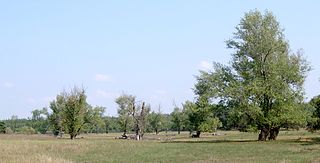
Populus nigra, the black poplar, is a species of cottonwood poplar, the type species of section Aigeiros of the genus Populus, native to Europe, southwest and central Asia, and northwest Africa.

Indian Head is a town in southeast Saskatchewan, Canada, 69 kilometres (43 mi) east of Regina on the Trans-Canada Highway. It "had its beginnings in 1882 as the first settlers, mainly of Scottish origin, pushed into the area in advance of the railroad, most traveling by ox-cart from Brandon." "Indian" refers to Aboriginal Canadians. The town is known for its federally operated experimental farm and tree nursery, which has produced and distributed seedlings for shelter belts since 1901. For many years the program was run by the Prairie Farm Rehabilitation Administration (PFRA).
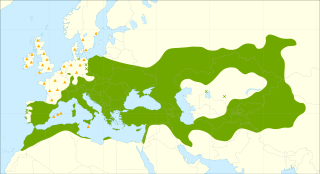
Populus alba, commonly called silver poplar, silverleaf poplar, or white poplar, is a species of poplar, most closely related to the aspens. It is native to Morocco and then Portugal through central Europe to central Asia. It grows in moist sites, often by watersides, in regions with hot summers and cold to mild winters.
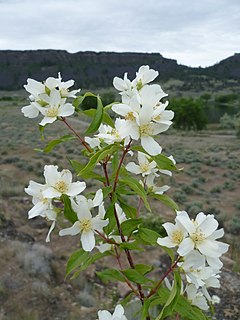
Philadelphus lewisii, the Lewis' mock-orange, mock-orange, Gordon's mockorange, wild mockorange,Indian arrowwood, or syringa, is a deciduous shrub native to western North America, and is the state flower of Idaho.
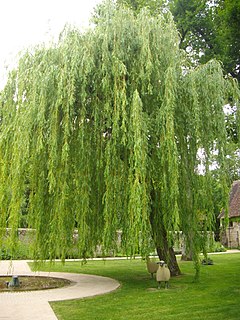
Salix babylonica is a species of willow native to dry areas of northern China, but cultivated for millennia elsewhere in Asia, being traded along the Silk Road to southwest Asia and Europe.
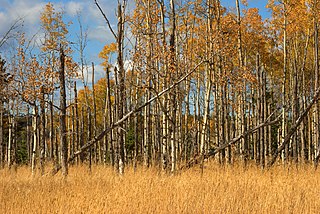
Aspen parkland refers to a very large area of transitional biome between prairie and boreal forest in two sections, namely the Peace River Country of northwestern Alberta crossing the border into British Columbia, and a much larger area stretching from central Alberta, all across central Saskatchewan to south central Manitoba and continuing into small parts of the US states of Minnesota and North Dakota. Aspen parkland consists of groves of aspen, poplar and spruce, interspersed with areas of prairie grasslands, also intersected by large stream and river valleys lined with aspen-spruce forests and dense shrubbery. This is the largest boreal-grassland transition zone in the world and is a zone of constant competition and tension as prairie and woodlands struggle to overtake each other within the parkland.

Populus tremuloides is a deciduous tree native to cooler areas of North America, one of several species referred to by the common name aspen. It is commonly called quaking aspen, trembling aspen, American aspen, mountain or golden aspen, trembling poplar, white poplar, and popple, as well as others. The trees have tall trunks, up to 25 meters tall, with smooth pale bark, scarred with black. The glossy green leaves, dull beneath, become golden to yellow, rarely red, in autumn. The species often propagates through its roots to form large clonal groves originating from a shared root system. These roots are not rhizomes, as new growth develops from adventitious buds on the parent root system.
The Siberian elm cultivar Ulmus pumila 'Chinkota' is from a seed-produced line of extremely cold-hardy and drought-resistant trees raised in the United States. The tree was developed from seed of the cultivar 'Dropmore' by the Horticulture & Forestry Department of South Dakota State University after World War II
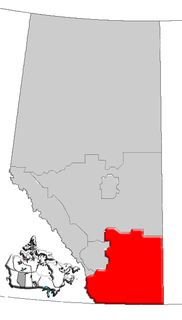
Southern Alberta is a region located in the Canadian province of Alberta. In 2004, the region's population was approximately 272,017. The primary cities are Lethbridge and Medicine Hat. The region is known mostly for agricultural production, but other sectors, such as alternative energy, film production and tourism, are emerging.

Populus tremula, commonly called aspen, common aspen, Eurasian aspen, European aspen, or quaking aspen, is a species of poplar native to cool temperate regions of Europe and Asia, from Iceland and the British Isles east to Kamchatka, north to inside the Arctic Circle in Scandinavia and northern Russia, and south to central Spain, Turkey, the Tian Shan, North Korea, and northern Japan. It also occurs at one site in northwest Africa in Algeria. In the south of its range, it occurs at high altitudes in mountains.

John Lineham was a territorial-level politician and businessman from Northwest Territories, Canada.
Robert James Berry was a New Zealand dendrologist who founded Hackfalls Arboretum at his farm in Tiniroto, Gisborne. The arboretum is now known for having one of the largest collections of Mexican oaks in the world. During the 1950s and 1960s he was in regular contact with William Douglas Cook, the founder of Eastwoodhill Arboretum, Ngatapa, Gisborne. Berry made the first catalogues of this arboretum, which is now the National Arboretum of New Zealand.
The Pearce Estate Wetland is a city park located in Calgary, Alberta. The park occupies 21 hectares along the Bow River to the east of downtown Calgary. It is described as "constructed wetlands filled with native plants and animals". The land was donated to the city around 1929 by then prominent Calgarian William Pearce.
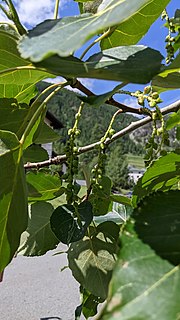
Populus × jackii is the hybrid between balsam poplar, Populus balsamifera, and the eastern cottonwood, Populus deltoides, occurring occasionally where the two parental species' ranges overlap. It is sometimes called a cottonwood. This hybrid is also sometimes planted as a shade tree, and occasionally escapes from cultivation. This hybrid is also known by the synonyms Populus × andrewsii Sargent, P. × bernardii Boivin, Populus candicans W. Aiton, P. × dutillyi Lepage, P. × generosa Henry, P. × gileadensis Rouleau, and P. manitobensis Dode.

John Walker was a Canadian horticulturist and plant breeder who developed numerous varieties of trees and shrubs. His selections have been used in shelterbelts and landscaping applications across Canada and in northern countries around the world. Some of his selections include:
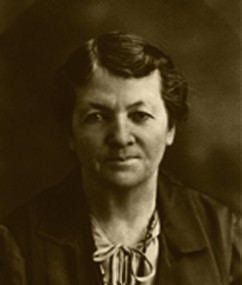
Fannie Mahood Heath was an American gardener who discovered methods for growing imported flowers. She created flower and fruit cultivars and corresponded and collaborated with academics. She was a founding member and vice-president of the National Horticultural Society and her garden would attract 100 visitors a week.
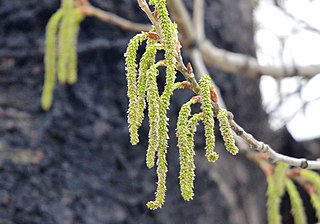
Populus × tomentosa, commonly known as Chinese white poplar or Peking poplar, is a species of tree in the family Salicaceae. It is found across northern and eastern China, and has been introduced to the US state of Louisiana.
















